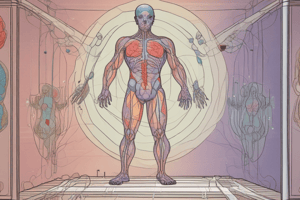Podcast
Questions and Answers
During the alarm stage of the stress response, which of the following is NOT a typical physiological change?
During the alarm stage of the stress response, which of the following is NOT a typical physiological change?
- Suppressed immune system
- Increased heart rate
- Increased blood glucose levels
- Increased insulin production (correct)
What is the primary function of the integrator in a negative feedback system that regulates homeostasis?
What is the primary function of the integrator in a negative feedback system that regulates homeostasis?
- Returning the body to a state of equilibrium
- Detecting changes in the internal environment
- Processing information and determining the appropriate response (correct)
- Sending signals to effector organs
Which of the following is a key difference between the General Adaptation Syndrome (GAS) and the Local Adaptation Syndrome (LAS)?
Which of the following is a key difference between the General Adaptation Syndrome (GAS) and the Local Adaptation Syndrome (LAS)?
- GAS involves a more localized response, while LAS affects the entire body.
- GAS is a longer-term response to stress, while LAS is a short-term response.
- LAS is a longer-term response to stress, while GAS is a short-term response.
- LAS involves a more localized response, while GAS affects the entire body. (correct)
During the resistance stage of the stress response, what is the body's primary goal?
During the resistance stage of the stress response, what is the body's primary goal?
Which of the following is NOT a direct effect of catecholamines released during the alarm stage of the stress response?
Which of the following is NOT a direct effect of catecholamines released during the alarm stage of the stress response?
What are the two primary catecholamines released by the adrenal medulla during the stress response?
What are the two primary catecholamines released by the adrenal medulla during the stress response?
Which of the following describes the function of the HPA axis in the stress response?
Which of the following describes the function of the HPA axis in the stress response?
Which of the following is NOT a characteristic feature of the fight-or-flight response?
Which of the following is NOT a characteristic feature of the fight-or-flight response?
What is the primary function of the parasympathetic nervous system during the stress response?
What is the primary function of the parasympathetic nervous system during the stress response?
During the alarm stage of the stress response, how does the sympathetic nervous system affect the endocrine system?
During the alarm stage of the stress response, how does the sympathetic nervous system affect the endocrine system?
What type of immunity is developed through vaccination?
What type of immunity is developed through vaccination?
What is the primary function of the Major Histocompatibility Complex (MHC)?
What is the primary function of the Major Histocompatibility Complex (MHC)?
Which immunoglobulin is the first antibody produced in response to an antigen?
Which immunoglobulin is the first antibody produced in response to an antigen?
Which type of hypersensitivity reaction is characterized by immediate allergic reactions like anaphylaxis?
Which type of hypersensitivity reaction is characterized by immediate allergic reactions like anaphylaxis?
What is the most abundant immunoglobulin found in all bodily fluids that can cross the placenta?
What is the most abundant immunoglobulin found in all bodily fluids that can cross the placenta?
How does HIV affect the immune system?
How does HIV affect the immune system?
Which immunoglobulin is primarily found in secretions such as tears and breast milk?
Which immunoglobulin is primarily found in secretions such as tears and breast milk?
What is the role of antigen-presenting cells?
What is the role of antigen-presenting cells?
What effect does aging have on immune homeostasis?
What effect does aging have on immune homeostasis?
Which of the following is associated with passive acquired immunity?
Which of the following is associated with passive acquired immunity?
Which of these cells are NOT directly involved in the body's innate immune response?
Which of these cells are NOT directly involved in the body's innate immune response?
Which of the following statements accurately describes the role of the Major Histocompatibility Complex (MHC) in the adaptive immune response?
Which of the following statements accurately describes the role of the Major Histocompatibility Complex (MHC) in the adaptive immune response?
How does the body maintain homeostasis during prolonged stress?
How does the body maintain homeostasis during prolonged stress?
Which of these is a characteristic of the immune response that is specific to adaptive immunity?
Which of these is a characteristic of the immune response that is specific to adaptive immunity?
What is the primary function of cortisol in the stress response?
What is the primary function of cortisol in the stress response?
Which of the following scenarios best describes an example of a successful innate immune response?
Which of the following scenarios best describes an example of a successful innate immune response?
Which of the following statements best describes the role of the complement system in immunity?
Which of the following statements best describes the role of the complement system in immunity?
Which of the following is NOT a known function of endorphins in the body?
Which of the following is NOT a known function of endorphins in the body?
Which of these cells is responsible for killing infected cells directly?
Which of these cells is responsible for killing infected cells directly?
How does immunization provide protection against future infections?
How does immunization provide protection against future infections?
Flashcards
Exhaustion
Exhaustion
A state where prolonged stress depletes the body's recovery and defense mechanisms.
Cortisol
Cortisol
A hormone produced by the adrenal cortex that regulates stress responses and metabolism.
Sympathomimetics
Sympathomimetics
Drugs that mimic the activity of the sympathetic nervous system.
Endorphins
Endorphins
Signup and view all the flashcards
Immunity
Immunity
Signup and view all the flashcards
Innate Immunity
Innate Immunity
Signup and view all the flashcards
Primary Defense
Primary Defense
Signup and view all the flashcards
Adaptive Immunity
Adaptive Immunity
Signup and view all the flashcards
T Lymphocytes
T Lymphocytes
Signup and view all the flashcards
Immunocompetence
Immunocompetence
Signup and view all the flashcards
Homeostasis
Homeostasis
Signup and view all the flashcards
Stress Response
Stress Response
Signup and view all the flashcards
Negative Feedback System
Negative Feedback System
Signup and view all the flashcards
Positive Feedback System
Positive Feedback System
Signup and view all the flashcards
General Adaptation Syndrome (GAS)
General Adaptation Syndrome (GAS)
Signup and view all the flashcards
Local Adaptation Syndrome (LAS)
Local Adaptation Syndrome (LAS)
Signup and view all the flashcards
Alarm Stage
Alarm Stage
Signup and view all the flashcards
Fight or Flight Response
Fight or Flight Response
Signup and view all the flashcards
Resistance Stage
Resistance Stage
Signup and view all the flashcards
Stress Hormones
Stress Hormones
Signup and view all the flashcards
Humoral Immunity
Humoral Immunity
Signup and view all the flashcards
Antigen
Antigen
Signup and view all the flashcards
IgG
IgG
Signup and view all the flashcards
CD4 Cells
CD4 Cells
Signup and view all the flashcards
Passive Acquired Immunity
Passive Acquired Immunity
Signup and view all the flashcards
Primary Immune Response
Primary Immune Response
Signup and view all the flashcards
HIV
HIV
Signup and view all the flashcards
Dendritic Cells
Dendritic Cells
Signup and view all the flashcards
Type 1 Hypersensitivity
Type 1 Hypersensitivity
Signup and view all the flashcards
Major Histocompatibility Complex (MHC)
Major Histocompatibility Complex (MHC)
Signup and view all the flashcards
Study Notes
Homeostasis
- Maintaining balance between the body's internal and external environments
- Requires feedback systems to regulate bodily functions
- Internal cellular waste is excreted into the external environment
Stress Response
- Control system is responsible for physical, emotional, and behavioral reactions to stressors
- Negative feedback system opposes the stressor
- Sensor detects change
- Integrator processes information
- Effector returns the change to normal
- Positive feedback systems cause instability rather than stability
General Adaptation Syndrome (GAS)
- Three-step process describing the body's reaction to stress
- Describes how the body responds to stressors
Local Adaptation Syndrome (LAS)
- Localized version of GAS
- Body's attempt to minimize the reaction/damage from stress in a smaller area of the body
Alarm Stage (GAS)
- Sympathetic nervous system and the HPA axis are stimulated leading to the release of catecholamines and cortisol
- Body prepares to confront or escape a threat
- Fight or flight response: part of the alarm stage
- Endocrine system and sympathetic system work together
- Parasympathetic system is suppressed
Response Symptoms and Signs (Alarm stage)
- Immune system: repressed/inhibited
- Heart: hypertension, faster heart rate, blood diverted to muscles
- Lungs: tachypnea (faster breathing), increased oxygen consumption, increased carbon dioxide expulsion
- Endocrine System: release of adrenaline and noradrenaline, cortisol
Resistance Stage (GAS)
- Body selects the most effective defense mechanism
- Body recovers from the threat, cortisol levels decrease
Exhaustion Stage (GAS)
- Prolonged stress overwhelms the body's ability to recover and defend itself
- Body becomes depleted of its resources
- Coping is unsuccessful
Cortisol
- Glucocorticoid hormone released by the adrenal cortex
- Increases the actions of epinephrine and glucagon
- Inhibits release and actions of reproductive hormones and Thyroid Stimulating Hormone (TSH)
- Decreases immune cells and inflammatory cells
Skin
- Increased sweating
Pancreas
- Hyperglycemia
- Reduced insulin production
Adrenal Medulla
- Releases epinephrine (adrenaline) and norepinephrine (noradrenaline)
Sympathomimetics
- Drugs that mimic the functions of the sympathetic nervous system
Endorphins
- Body's natural painkillers
- Released during times of stress and exercise from the hypothalamus and pituitary gland
Immunity
- The body's ability to defend itself against pathogens and foreign substances
Lines of Defense
- Primary (innate): non-specific, physical and chemical defenses (skin, mucous membranes, stomach acid, lysozyme)
- Expulsion (coughing, sneezing, vomiting, diarrhea)
- Secondary (innate): macrophages, neutrophils, eosinophils, basophils, monocytes
Adaptive Immunity (Specific/Acquired)
- 3rd line of defense; response developed after antigen exposure
- Cellular: T lymphocytes (mature in the thymus gland) that kill infected cells directly
- Humoral: B lymphocytes (mature in the bone marrow) produce antibodies targeting foreign substances
Complement System
- Group of proteins that fight off infection, viruses, bacteria, and promote tissue healing
Antigen-Presenting Cells
- Help bridge innate and adaptive immunity
- Also known as dendritic cells, responsible for activating T lymphocytes
Antibody-mediated Response (Primary Phase)
- IgM marks the primary response
- Host cell is exposed to antigen, and proliferation of Igs neutralizes the invader
Antibody-mediated Response (Secondary/Amnestic Phase)
- IgG marks the secondary response
- A second exposure to the same antigen leads to a stronger response with higher IgG levels
Immunoglobulins
- Antibodies/protein molecules
- IgG: most abundant, antiviral, antibacterial, and antitoxin properties. Can cross the placenta.
- IgA: found in secretions (tears, saliva, breast milk)
- IgM: first antibody produced, responsible for primary immune response
- IgE: involved in allergic reactions
Hypersensitivity
- Type 1: immediate hypersensitivity (e.g., allergic reactions, anaphylaxis)
- Type 2: cytotoxic (e.g., blood transfusions, autoimmune diseases like myasthenia gravis)
- Type 3: immune complex deposition (e.g., systemic lupus, rheumatoid arthritis)
- Type 4: delayed hypersensitivity (e.g., contact dermatitis, poison ivy rash)
Immunization
- Active: long-term immunity (e.g., contracting a disease or receiving a vaccine)
- Passive: short-term immunity (e.g., receiving preformed antibodies via breast milk, injection)
HIV/AIDS
- Attacks CD4 cells and macrophages, slowly debilitating T cells/B cell immunity.
- Transmission routes: blood, sexual activity, saliva, breast milk, transplants, transplacenta
- Diagnosis: measuring HIV antibodies, viral loads, and CD4 cell counts
- HIV PrEP/HAART: antiretroviral medication for treatment
Major Histocompatibility Complex (MHC)
- Allows the body to differentiate between self and non-self antigens on cell surfaces.
- Enables adaptive immunity.
- Also known as human leukocyte antigens (HLA).
Studying That Suits You
Use AI to generate personalized quizzes and flashcards to suit your learning preferences.




